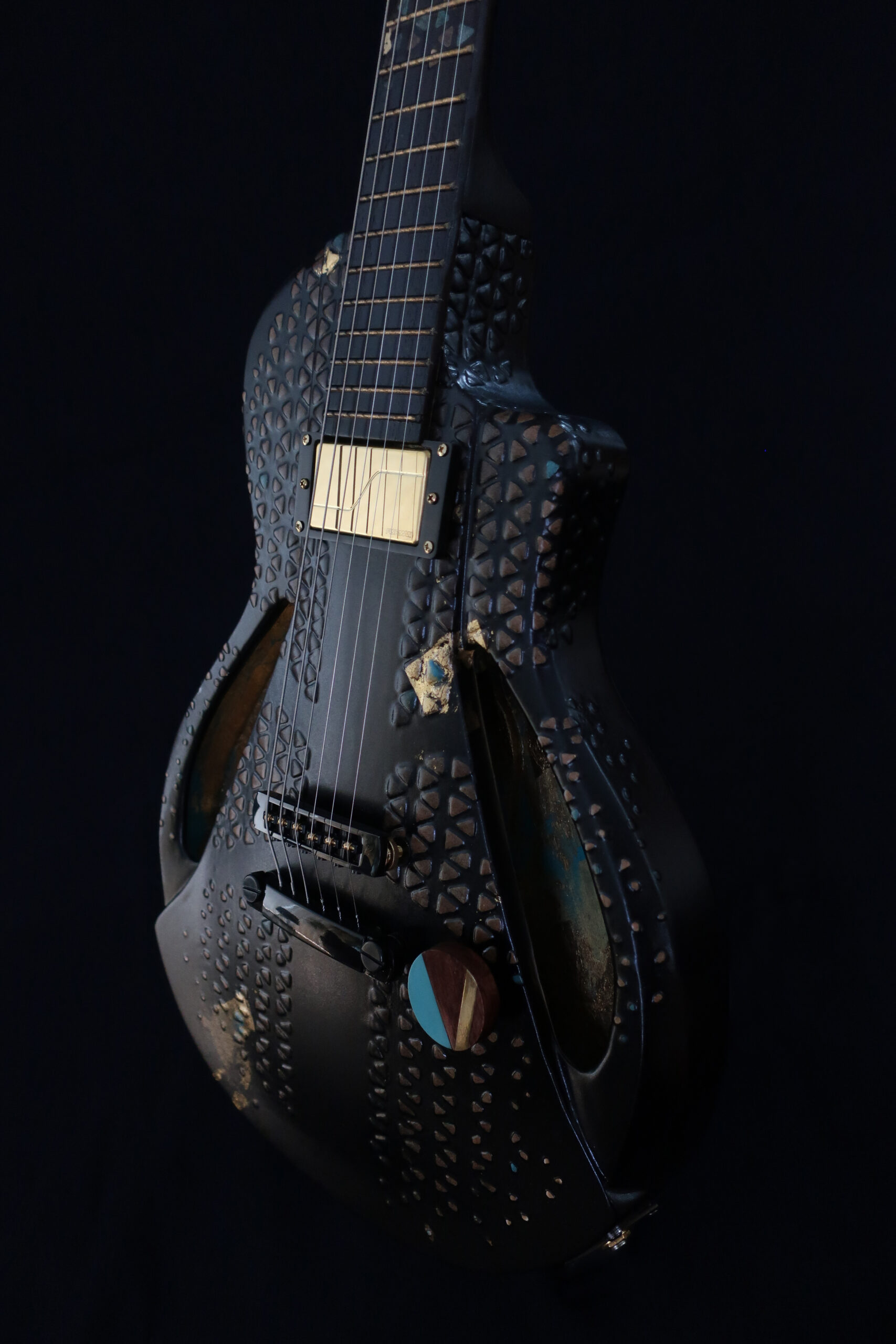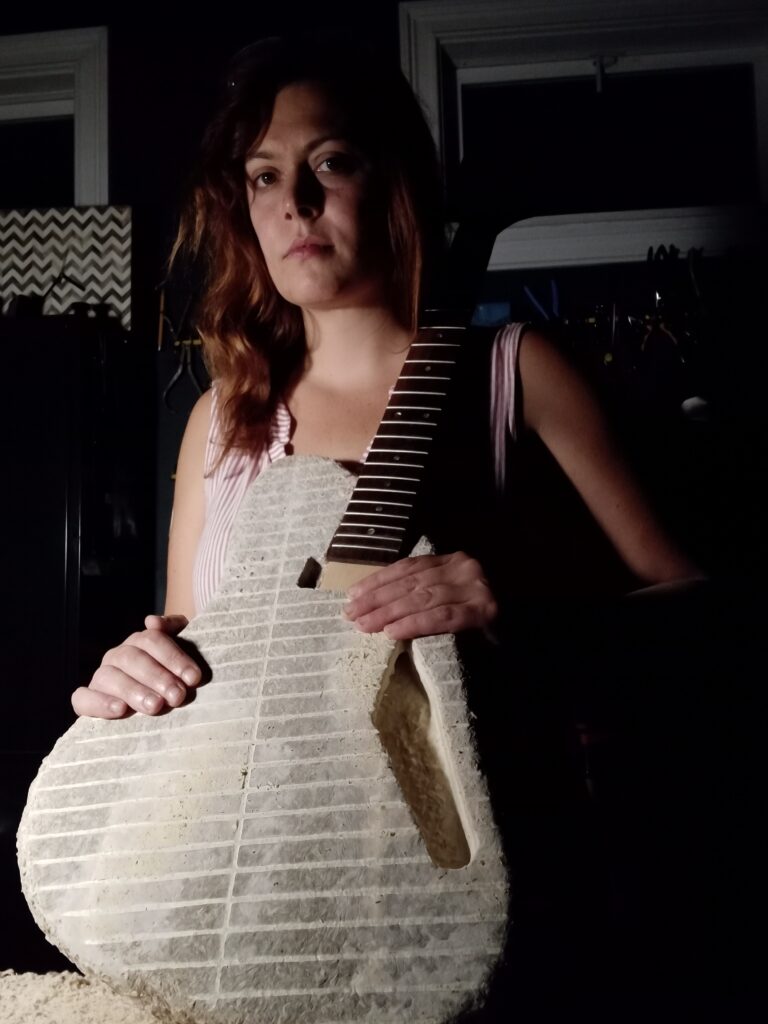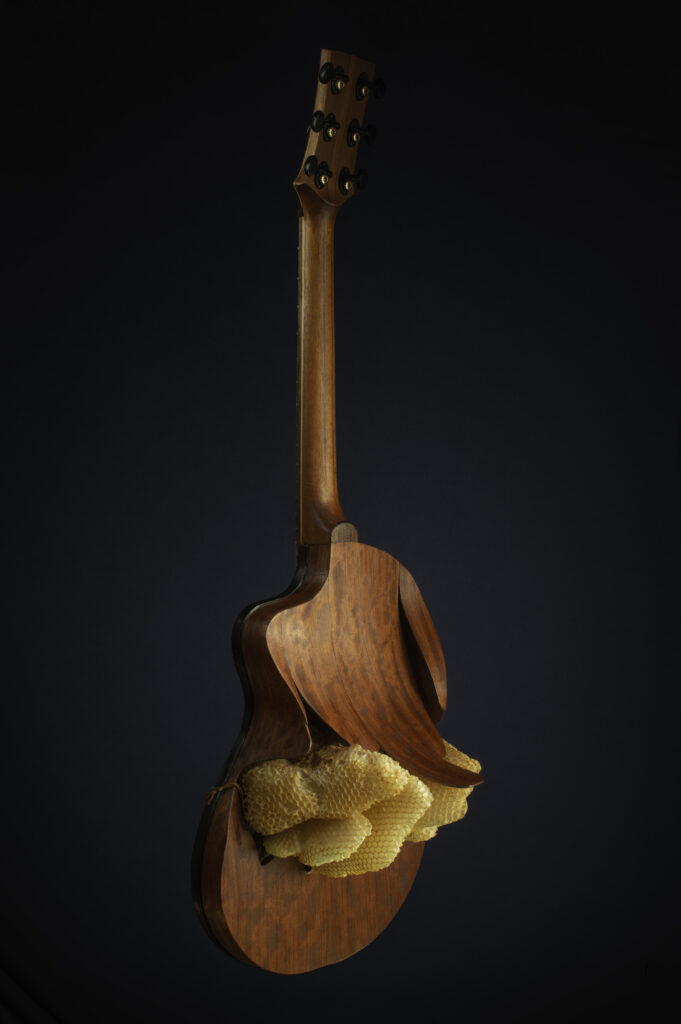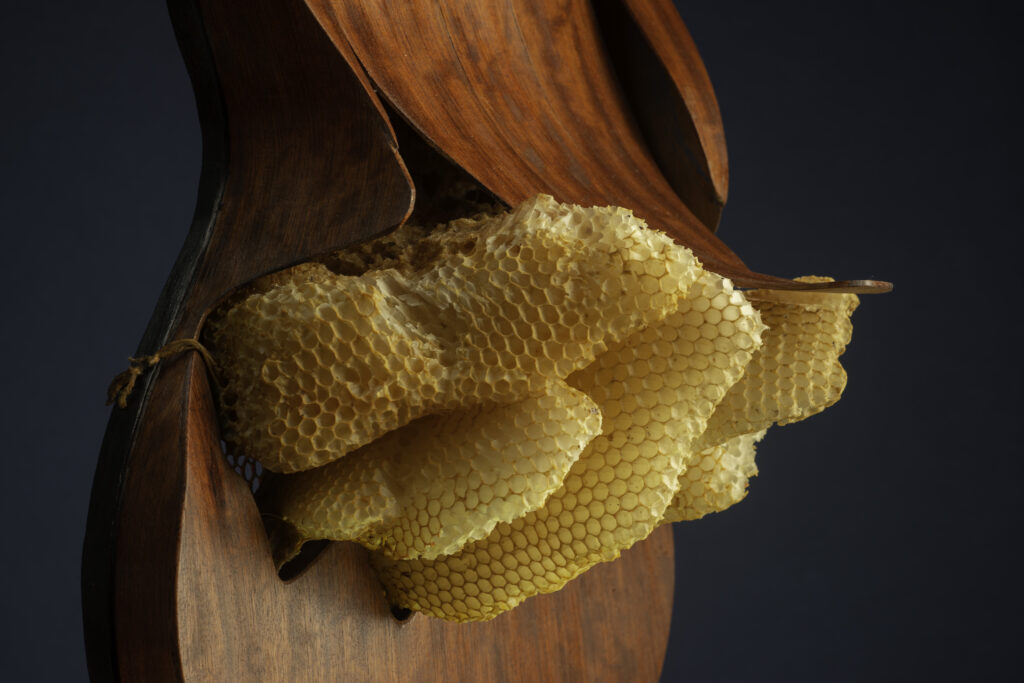Rhode Island Luthier Makes Guitars that Sing Using Mushrooms, Honeycomb
July 3, 2022
During the pandemic lockdown, local guitar-maker Rachel Rosenkrantz collected shells from her daily two-egg breakfast. They seemed an appropriate — and certainly plentiful — biomaterial to integrate into a USB-chargeable electric guitar she was working on.
“Calcium is an integral part of violin varnish because it contributes to the sound quality,” she explains. With this in mind, and inspired by the work of Gaston Suisse, a French art deco artist who worked with eggshell inlay, she used a laser cutter and manicure file to shape her collected shells into tiny triangles. The eggshell guitar was the last in a series of biomaterial-based instruments she completed during the pandemic. “I did not have a boring lockdown,” she says with a laugh.
Guided from France over Zoom by her best friend, who happens to be a lacquer artist, she arranged the shells on the guitar body in colors and a design inspired by the landscapes of Normandy, where she spent summers as a child. The inside is painted with gold leaf to reflect and direct sound, and the result is elegant, yet the studded eggshell gives the guitar a punk edge.
Leap before you look
Rosenkrantz had a thriving and well-established career as a commercial furniture and lighting designer when, 10 years ago, she had an epiphany.
“I can always make money,” she says. “But I can’t make time.” This realization propelled her to follow her dream to become a luthier. “I was learning a lot [in my career],” she says. “But I was not a fan of the cube. I missed music. I missed working with my hands. And I had been daydreaming about being a luthier for too long to not do it.”

To Rosenkrantz, taking this risk was imperative, but not without drawbacks. “It was like pulling the rug out from under my own feet,” she says. “But I don’t regret it.”
Rosenkrantz grew up just outside Paris in Montfermeil, an industrial town she describes as “the Fall River of France.” She is the daughter of a family of tailors; her grandfather lived in an apartment above his small tailoring shop that housed not much more than a sewing machine and a bench, and Rosenkrantz spent many childhood days there, listening to French radio at her grandfather’s side.
Rosenkrantz studied at l’ESAG in Paris, and in her college days, crossed the ocean a couple of times, first as an exchange student at the Rhode Island School of Design — “I loved the name ‘Providence,’” she recalls — then to return to Paris to finish her design degree. She now lives just outside Pawtuxet Village in Cranston, and the mothers who bring their children to the school across the street know her, if not by name. To them, she’s the woman who sits on her flower-draped balcony, strumming a guitar. Her balcony leads to a charming, light-flooded apartment above her guitar-making studio, Atelier Rosenkrantz. “I guess I’ve come full circle,” she says, referencing her grandfather’s shop. “Living above a work studio feels comfortable to me. This is my happy place.”
Career sustainability
Her cozy studio may be a happy place, but it’s not a sheltered one. Rosenkrantz is well aware of the negative impact guitar-making has on the environment. Though little seems more environmentally conscious than someone sitting outside plucking a guitar, guitars are made from wood. And it isn’t always harvested in a sustainable way.
Traditionally, luthiers seek rare types of tonal wood, such as rosewood, spruce, mahogany, and ebony, because of their acoustic properties. The trees are felled, then cut perpendicular to their rings to ensure strength and proper sound transmission. Only old-growth trees provide cuts large enough to be a guitar’s front or back face, and it can take an ebony tree decades to reach the proper size.
“I became aware of the environmental issues pretty fast,” Rosenkrantz says. “It’s an ongoing conversation in the community.”
Rosenkrantz relies on timber updates from the Convention on International Trade in Endangered Species of Wild Fauna and Flora, a Switzerland-based organization that, through international agreement, offers a framework to ensure that when plants and animals cross borders, a species’ survival isn’t threatened.
“Brazilian rosewood is a big no-no because their rainforests were depleted,” she says. But it isn’t just the type of wood used that she considers; she also considers how a country manages its resources. “India, for example, manages their rosewood really well,” she adds.
Protection of species is important, but so is protection of a country’s citizens. When buying wood from overseas, Rosenkrantz considers whether local resources are accessible to and benefit the country’s citizens or if forests are managed by foreign interests whose profits benefit their own country. And, of course, the environmental impact of shipping also has to be taken into account.
“I’m very lucky to have access to maple and walnut, tonal woods native to New England,” she says.
Other guitar-makers are beginning to experiment with overlooked woods in their own regions. “When we discover these underdogs locally, then wood doesn’t have to travel across the world,” Rosenkrantz says. “In Michigan and Illinois, makers are starting to use Osage orange. Poplar was always considered a trash wood, but it has pretty good tonal quality and it grows quickly.”
Replenishment also is important. “Every guitar-maker, every woodworker — if we consume wood, we should grow wood,” she says.
The alternative, of course, is to not use wood at all.
A growing practice
On the bench in front of Rosenkrantz is an electric guitar body. It’s off-white, lightweight, and has a texture a bit like shredded wheat. Her energy shifts as her focus falls on it, and she dashes off to find her sound diffuser, a small tool that connects to her phone through Bluetooth and plays music to test the resonance of a guitar body.
“This thing is so fun,” she says. “What should we listen to? Beastie Boys?” She settles on French guitarist Stephane Wrembel, and when she places the sound diffuser on the guitar body, the room fills with gypsy jazz.

One afternoon Rosenkrantz was at RISD, where she teaches spatial design, and decided to spend some time in the Nature Lab.
“RISD has a whole library of natural specimens, including biomaterials,” she says. “IKEA recently switched from using Styrofoam to using mushroom-based packing materials. I figured they must be similar. And I know that Styrofoam conducts sound because it’s full of air, so I tested RISD’s mushroom sample with my sound diffuser and realized that I could make a solid body sound like a hollow body.”
The thing that excites her most about using farm waste inoculated with mushrooms in her craft is that she can grow her own design — a plastic mold is at her feet, leaning against the bench. “It takes about a week to grow a guitar body — four days to grow, then four days to let a crust develop,” she says. The next step is to bake it to arrest the mushroom’s growth, and she gestures to a shelf of failed experiments that, like fallen trees, sprout mushrooms from their edges.
“My goal is to make a lightweight, biodegradable guitar that costs about 50 bucks,” Rosenkrantz says. “If you play on stage for hours, if you travel, you want something light. And there are so many kids who can’t play music because their family can’t afford an instrument.”
Her prototype is light, but it isn’t strong, a problem she solved by creating a bridge that goes through the guitar body rather than stopping at its tip. To keep the bridge lightweight and biodegradable, she’s experimenting with paper layered with bio-resin to make a product that’s as hard as wood.
Trash to treasure
Fish leather was Rosenkrantz’s first foray into biomaterials. A guitar expands and contracts as the seasons change. But its pickguard — a “horrible” piece of plastic glued to the body of a stringed instrument to protect its finish from misjudged picking or overly long fingernails — lacks the same flexibility.
“The wood and the plastic begin to wrestle,” she says. “Then the pickguard peels off or the guitar cracks.” She wondered if there was something in nature that could protect the guitar’s finish while offering flexibility.

“There’s a woman in São Paulo [Brazil] who makes tilapia leather with her sister,” Rosenkrantz says. “They live near a tilapia farm and took the fish skin — which used to be trash — and turned it into a successful business.”
The fish leather is beautiful. The scales catch the light as Rosenkrantz rifles through a basket of colorful samples, demonstrating the material’s flex. “I like it when form and function have a nice equilibrium,” she says.
Chelsea Parris is a Providence resident and fledgling guitarist who can attest to the balance of form and function in Rosenkrantz’s guitars. Parris’ husband gifted her with a custom-built guitar from Atelier Rosenkrantz so that she could fulfill her New Year’s resolution that she learn to play.
“The guitar I have is a work of art,” Parris says.
Hers is a parlor guitar made of Indian rosewood, sinker redwood, figured maple, and mahogany, with a fish leather pickguard. “The fish skin is a beautiful, shimmering gold color,” Parris says. “It’s subtle and pretty to touch.”
Parris says her favorite thing about the guitar is the detail. “She shaped it for comfort,” she says, describing its built-in armrest. And Rosenkrantz recently added one more detail to Parris’ instrument. Parris describes it: “She made a guitar pick for me with wood that matches the guitar, and she incorporated the same fish leather into the box it came in.”
Fermenting ideas
The pandemic lockdown allowed Rosenkrantz to fully delve into her experimentation with biomaterials. “The lockdown was a blessing and a curse,” she says. “If musicians aren’t working, I’m not working, and all my commissions got suspended. But I finally got the time to explore the things I wanted to work on.”
She slides a banjo from a shelf behind her and explains the body is made from kombucha leather. Kombucha home brewers are familiar with a symbiotic culture of bacteria and yeast (SCOBY), a cellulose mat that forms from the basis of kombucha — sweet tea — and houses the cultures that turn sweet tea into more kombucha. To get a SCOBY large enough make adequate leather for a banjo, Rosenkrantz brewed kombucha in a fish tank.
“It took 11 tries before I made enough leather for one instrument,” she says, describing how she experimented with growth speed and drying techniques, wrinkling her nose at the memory of the vinegary scent that permeated her apartment.
Her next project was a collaboration that required admirable patience. If Rosenkrantz can find music in packing material, fish farms, fermented drinks, and breakfast, it’s no wonder she found it in a beloved hobby.
Domesticated, but not tamed
Rosenkrantz began dabbling in beekeeping, and as she researched hive options, quickly discovered the top bar beehive, which is different from the familiar Langstroth hive. “That’s the one that looks like a filing cabinet,” she says.
A top bar beehive is simply a horizontal box with bars on top that support honeycomb, and it allows bees to build the way they would in nature. “[In nature], bees make scalloping, meandering honeycomb shapes,” Rosenkrantz says.

Some scientists have begun to speculate that bees communicate with each other through vibration when they are in the hive, and honeycomb’s structure allows for the vibration to travel. Rosenkrantz began to puzzle an idea together.
“The bars in a top bar hive reminded me a lot of the bracing that goes in the front of a guitar that provides rigidity and guides sound,” she says. “Honeycomb is resonant. Worker bees hum at a frequency of 309 Hz [hertz], which is in the guitar range. I wondered if I provided the bees with bracing, if I could trick them into building a guitar.”
But bees are not so easily tricked. “Bees have their own egress and architectural code,” Rosenkrantz says, and she had to learn those codes to encourage the bees to collaborate on a design.
So, after a great deal of research, she built a bracing structure according to the bees’ blueprint, placed it in a hive, and waited for a year. The result was something she never could have anticipated. The bees not only accepted her design and built their comb along her bracing structure, but they maintained the wood.
“Bees like to keep things sterile,” she says. “So if they discovered a crack in the wood, they’d fill it with propolis,” which is a resin-like material bees use for hive defense.
The bees’ repairs evoke kintsugi, the Japanese art of pottery repair in which broken bits are pieced back together with gold-dusted lacquer, resulting in a piece that, because of its flaws, is more beautiful than the original. “We really worked together,” Rosenkrantz says of her collaboration with the bees. “It was a full back and forth.”
Another thing she didn’t anticipate? “I didn’t know how fast they’d fill it with honey! I had this very heavy, honey-filled guitar. And I didn’t want to take their food away from them for the winter,” she says, describing the beginning of the wait before she could complete the instrument. But throughout the winter, the bees cleaned the honeycomb, leaving her with a bassy-sounding bracing structure, and she brought it into her shop in the spring to finish the project.
A large cardboard box marked “fragile” rests on the floor of her shop. She opens it and lifts the result of her bee collaboration from its depths. It’s exquisite. The wood is a rich mahogany and has an organic shape. It dances with the honeycomb, sometimes curving to mimic the bees’ structure, other times leaving space for the honeycomb to burst from the guitar body. “Smell it,” she says, and the sweet, gently floral aroma of beeswax and honey rises from the instrument.
“With time, it will vanish,” Rosenkrantz says. “But I’m OK with that. I like that it’s ephemeral.” And the guitar is indeed made more beautiful by its delicate, fleeting nature. “I love the poetry of it,” she says of her project. “That it worked at all is a miracle.”




Rachel,I totally enjoyed reading this article. You are a wonderful creative person. Keep up the inovative work you do. You are an inspiration. Best, Guy
Really innovative now you need to get a well known musician to play your guitars.
Your work is fantastic, what good design is all about!
What a fantastic article. Not surprised it made the top 10 for 2022.
Absolutely brilliant. Art, Biology and outstanding craftsmanship.